The Vulturine Guinea Fowl (Acryllium vulturinum) is a striking and visually captivating bird native to the dry savannas, grasslands, and open woodlands of northeastern Africa, primarily in countries like Kenya, Ethiopia, and Somalia. Known for its dramatic and vibrant appearance, this guinea fowl stands out as one of the most beautifully adorned species within the Numididae family.
Physical Appearance:
The Vulturine Guinea Fowl is a medium-sized bird, typically measuring around 50 to 60 cm (20 to 24 inches) in length and weighing between 1.5 to 2 kg (3.3 to 4.4 lbs). Its most remarkable feature is its striking blue and black plumage, which is intricately patterned with bright white streaks. These patterns, combined with its vivid cobalt-blue body, give it an almost iridescent appearance, setting it apart from other guinea fowl species.
However, the bird’s name comes from its distinctive head, which is bare and red, resembling that of a vulture. The head is small and bald, with a wattle (a fleshy, fleshy protrusion) hanging from the neck, adding to the vulture-like resemblance. The lack of feathers on the head and neck, coupled with the red, leathery skin, creates a sharp contrast with the colorful, patterned body. Its face features a deep blue around the eyes, and the bird has a small casque on top of its head. These unusual characteristics lend the Vulturine Guinea Fowl a somewhat otherworldly appearance.
Habitat and Distribution:
The Vulturine Guinea Fowl inhabits the arid, scrubby regions of northeastern Africa, favoring open savannas, bushlands, and grasslands, often in areas with scattered trees and bushes that provide cover and nesting sites. They thrive in regions with a warm climate and relatively low rainfall, but they are also adaptable to various habitats within their range. These birds are primarily ground-dwelling and are most commonly seen foraging in the open savanna or grasslands, where they can find seeds, insects, and small plants.
Vulturine Guinea Fowls are non-migratory and are usually found in specific territories across their range. They are well-adapted to the dry, arid conditions of northeastern Africa, where they can endure the harsh temperatures and limited water sources.
Behavior and Social Structure:
Vulturine Guinea Fowls are highly social birds, often found in small groups or flocks, which can range from 5 to 30 individuals. They are known to form tight-knit family groups, and their social dynamics are important for their survival. Flocks are generally made up of related individuals, and the birds rely on each other for protection from predators.
These guinea fowls are also quite vocal, communicating with one another through loud calls, often during the early morning and late evening hours. Their calls are somewhat harsh and sharp, used to keep the flock together, alert the group to potential threats, and maintain social bonds. Though they can be timid, Vulturine Guinea Fowls are quick to take flight if threatened, using their strong wings to escape predators, although they prefer to stay on the ground for most of their activities.
Their diet consists mainly of seeds, berries, roots, and small insects, though they may occasionally consume small reptiles and amphibians. Vulturine Guinea Fowls are known for their foraging behavior, which often involves scratching at the ground with their feet to uncover hidden food. They are often seen foraging in the morning or late afternoon when the temperatures are lower.
Reproduction:
The breeding season of the Vulturine Guinea Fowl generally coincides with the rainy season, when food is abundant. These birds are monogamous during the breeding season, and courtship is a display of mutual attention and vocalizations. The male performs various displays to attract the female, including puffing out his chest and performing a series of calls.
Once paired, the female builds a nest on the ground, typically hidden under dense vegetation or in tall grass, where she lays a clutch of about 4 to 8 eggs. The eggs are olive-brown or greenish with dark speckles. The female incubates the eggs for around 24 to 28 days, with the male often guarding the nest and helping to protect it from predators. Upon hatching, the chicks are precocial, meaning they are able to walk and follow their mother within hours. They are closely attended by both parents, and the family stays together as the chicks grow.
Conservation Status:
The Vulturine Guinea Fowl is currently listed as Least Concern on the International Union for Conservation of Nature (IUCN) Red List. This is due to the bird’s relatively stable population across its range, as well as its adaptability to a variety of habitats. However, localized threats such as habitat destruction and hunting for food, feathers, and trade are potential concerns for certain populations. The species does not face significant overall threats, and conservation efforts are focused on habitat protection and sustainable management of natural resources in the regions where they live.
Domestication:
Unlike the Helmeted Guinea Fowl, the Vulturine Guinea Fowl is not commonly domesticated, although some people in its native range may keep them for ornamental purposes or as a source of meat and eggs. Their striking appearance and interesting behaviors make them a subject of fascination in aviaries and bird collections.
Conclusion:
The Vulturine Guinea Fowl is a visually stunning bird with one of the most distinctive appearances in the guinea fowl family. With its brilliant blue plumage, striking white patterns, and vulture-like head, it is an unmistakable species in its native habitats. Beyond its beauty, the Vulturine Guinea Fowl’s social nature, foraging behaviors, and adaptability make it an interesting and resilient species that thrives in the challenging environments of northeastern Africa. Its fascinating appearance and lively habits make it a true icon of the African savanna.

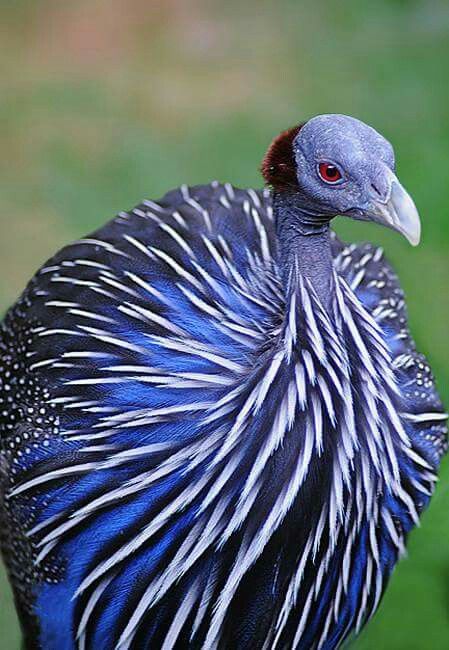
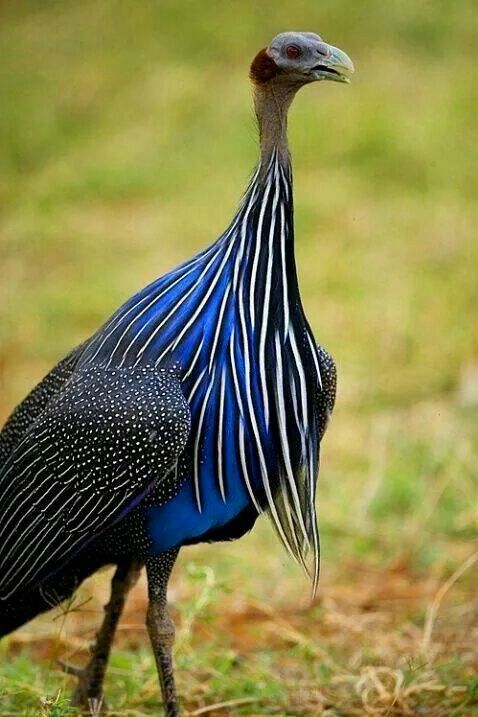
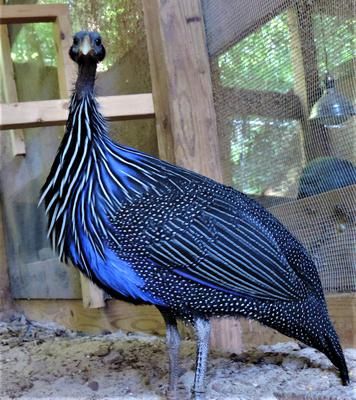

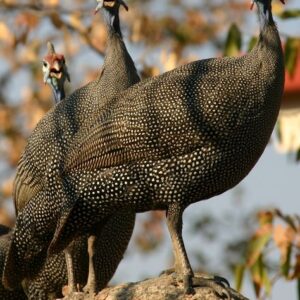
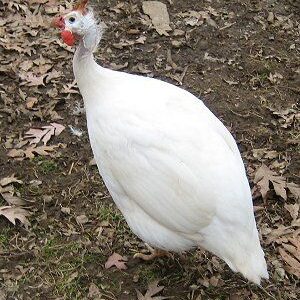
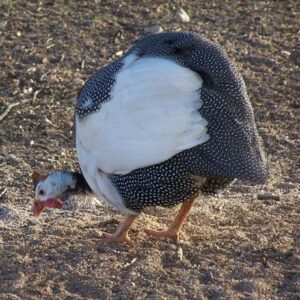
Reviews
There are no reviews yet.